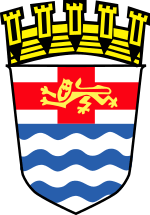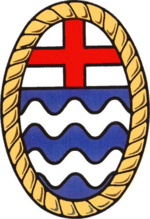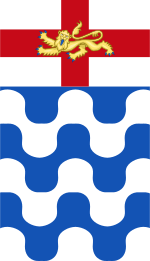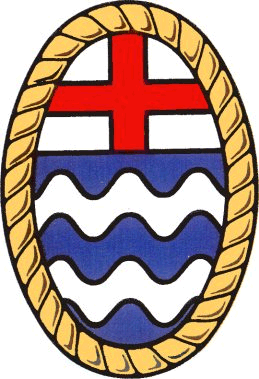Coat of arms of London County Council facts for kids
Quick facts for kids Coat of arms of London County Council |
|
|---|---|
 |
|
| Versions | |

Stylised version
|
|

Heraldic badge
|
|

Heraldic banner
|
|
| Armiger | London County Council |
| Adopted | 1914 |
| Crest | Mural Crown |
| Blazon | Barry wavy of six azure and argent, on a Chief of the last the cross of St George charged with a lion of England |
The London County Council (LCC) was a very important local government body. It managed many things in London from 1889 to 1965. Think of it like the city's main decision-making group.
In 1914, the LCC was officially given its own special symbol, called a coat of arms. Later, in 1956, they also received a smaller symbol known as a heraldic badge. You can still see the coat of arms on some old buildings that the council built before it stopped existing in 1965.
Contents
Why Did the LCC Need a Coat of Arms?
By the late 1800s, the London County Council was using a simple design. It showed a female figure with symbols from the Cities of London and Westminster. But some people thought the council should have a proper coat of arms.
In 1897, the idea of getting an official coat of arms was first discussed. Some members didn't think it was necessary. They felt a democratic group like the LCC didn't need such a traditional symbol.
However, others believed a coat of arms would be a good way to remember the council's important work. This included building new streets and bridges, and fixing up old buildings.
For a while, nothing much happened. Then, in 1911, the idea came up again. But the council decided against it. Some members felt that the letters "L.C.C." were enough to represent them.
Designing the LCC Coat of Arms
Things changed in 1914 when the council's chairman, Cyril Cobb, offered to pay for the coat of arms himself. This helped move the process forward.
Discussions began with the College of Arms, which is the official body for coats of arms in England. They came up with some ideas for the design.
One early idea for the shield included:
- A cross with a crown.
- Symbols of the Tower of London (for strength).
- Ancient ships (for London's shipping importance).
- A lion of England at the top.
For the crest (the part above the shield), they thought about a lion holding a flag of Saint George. The supporters (figures on either side of the shield) were planned to be a Roman officer and a Saxon warrior. These would represent London's ancient history.
They even suggested a Latin motto: loci dulcedo nos attinet. This means "the pleasantness of the place holds us." It was taken from an old Roman book and was one of the earliest mentions of London.
The Official Coat of Arms of London County Council
The final design for the coat of arms was approved by the council on May 26, 1914. It was chosen to be simple and clearly represent London's community life.
The official description of the arms is:
- Shield: It has six wavy blue and silver stripes. At the very top, there's a white section with a red St George's cross. On this cross, there's a golden lion of England.
- Crest: A golden mural crown sits on top of the shield.
Let's break down what these symbols mean:
- Blue and Silver Waves: These wavy lines represent the River Thames. The Thames is London's famous river and was very important for trade and the Port of London.
- St George's Cross with the English Lion: This part shows that London is the "Royal centre of England." It highlights London's role as the nation's capital city.
- Golden Mural Crown: A mural crown looks like a wall with towers. It's a common symbol used in heraldry to show that the arms belong to a city or local government body.
Because the design included part of the royal arms (the English lion), a special permission called a royal warrant was needed from the King. This was given on July 29, 1914. The arms were officially recorded on October 20, 1914.
In 1953, the council updated how the arms looked, but the design itself stayed the same.
The LCC Heraldic Badge
The coat of arms was only for the London County Council itself. But the council wanted a symbol that other groups, clubs, and societies connected to the County of London could use.
So, they applied for a heraldic badge. This badge was officially granted on March 12, 1956.
The badge's design was:
- An oval shape, mostly blue.
- Inside the oval, there are two wavy silver lines (like the river).
- At the top, there's a red St George's cross.
- The whole badge is surrounded by a golden rope.
The badge used the same main symbols as the coat of arms: the blue and silver waves for the Thames, and the St George's cross. The golden rope around the badge was added to represent London's strong connection to the sea and shipping.
The council allowed groups and clubs linked to the County of London to use this badge, as long as they followed certain rules.
See also
- Coat of arms of the City of London
- Armorial of London


